

1 Killing site(s)
Ion S., born in 1923: “When the occupation started, the Romanians set up a gendarmerie post office in Petreni. The chief of the post office and three gendarmes lived in the house just next to the post office building. Sometime later,
I became one of the premilitaries following an order of the chief of the post. After the execution of Jews, a young Jewish land lord called Mortko was caught hiding. He was brought to the post office and I received an order, as a premilitary, to guard him. During the night, he committed suicide by hanging himself from the rim of the well with his shirt sleeve. He was only 25 years old (…)”. (Witness N°69, interviewed in Dominteni, on December 7th 2012)
“The commission received the information that the Jews from the village of Petreni, as well as those transferred from the city of Balti, were shot and drowned by the Romanian occupants in July 1941. The extermination process was conducted in the following way: The Jewish residents of Petreni were shot, while the Jews transferred from the Balti district were taken to the pond. After having attached a group of 10-15 people with a barbed wire on the edge of the pond, the last one from the group was pushed and fell inside pulling all others down with them. The pit was filled in two days later.
The mass grave containing the victims’ bodies is located 500m south east of the village of Petreni, behind the pond. As a result of the forensic research on the site, one mass grave containing 50 bodies was identified. According to the testimony of the local witness Petro Ts., the commission found out that that the civilians were arrested by Romanian occupants in July 1941. The execution was conducted by the chef de post, Lepoduş, and Romanian gendarmes (whose names weren’t identified) […].
Among the shot victims residents of the village of Petreni were:
1. Abram Chertnovitz, the head of the selsoviet;
2. His elderly mother, 53 years old;
3. Khori –the farm head of the village of Petreni, his wife and three children, aged 18 [sic] to 18 years old.
4. Khaim Vondar, in charge of procurements of the farm, village of Petreni with his wife and two daughters, aged from 7 to 15 years old.
In all, 11 people were shot and 39 were drowned after having been pushed from a 7m bank on the side of the pond. Not all the victims belonged to [communist] party, but all were Jewish.”
[Act n°2 drawn up by Soviet State Extraordinary Commission (ChGK) on May 10th 1945; GARF 7021-96-84]
Petreni is a commune in Drochia District in northern Moldova. It is made up of two villages, Petreni and Popeștii Noi. Before the outbreak of the Second World War, Moldovans, sedentary Gypsies and several Jewish families lived in the village. Little is known about the Jewish community of Petreni. Thanks to YIU’s witnesses we know that the Jews were mainly merchants. They owned and ran several shops in the village.
When the Second World War broke out, the village was occupied by Soviets until July 1941. Many Jews escaped with the Soviet army before the arrival of the Romanian troops. Once the Romanian soldiers arrived in the village, they rounded up the remaining Jews in the basement of a local Jewish house, where they were kept for about two days. In the meantime, the Romanians kept transferring Jews from surrounding villages to the same location. One night, the Jews were removed from the house and taken to the outskirts of the village, near the Cubolta river, not far from a mill. Romanian soldiers lined them up on the riverbank and threw them into the water to drown. According to Vasile C., born in 1928, “the Jews had been tied together with telephone wires. In addition, stones were tied around their necks to force them to drown.” After the execution, four local premilitaries were requisitioned to remove the bodies of the victims from the river, but they only manage to reach a few of them. The rest were carried away by the current of the river. Vasile C., interviewed by Yahad, recalled another execution that took place about a week later. Sixteen Jewish women, some with children, were gathered in a local field, not far from the river, where they were guarded for a few days. Then, they were brought to a trench where they were shot by local gendarmes along with their children. After the shooting, the mass grave was covered with soil by requisitioned premilitaries. Today, there is no memorial on the site.
Do you have additional information regarding a village that you would like to share with Yahad ?
Please contact us at contact@yahadinunum.org
or by calling Yahad – In Unum at +33 (0) 1 53 20 13 17